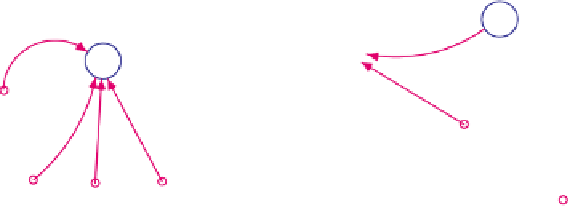Database Reference
In-Depth Information
EXPECTED DENSITY
SUSTAINABLE POPULATION
TOTAL POPULATION
LAKE BOTTOM
~
EXPANSION PERCENT
JUVENILE
HARD SUBSTRATE
POPULATION DENSITY
ADULT 1
ADULT 2
ADULT 3
SUBSTRATE PERCENT
Fig. 10.2
Available hard substrate is calculated by multiplying the total area of the lake
bottom by the percent of the lake bottom that is hard. This percentage can only be
estimated, and its initial value is given. To determine the sustainable population at
any point in time, the average density and distribution of the population must also be
known. Observed density figures vary widely in the literature. Therefore, we have
chosen a range over which we run our model. Our expected density figure is taken
to be that density which is sustainable over the long term.
The expansion percent parameter shows the percent of the lake that has been
colonized over time and is represented in graphical form. We are assuming that
infestation occurs at a specific point (as from an infested bait bucket dumped over-
board) and spreads from there. Zebra mussel larvae are distributed via lake currents
as well as boat traffic. We assume that in the first month, 20% of the lake is infested
with the mussel. The expansion percentage increases drastically during the first few
months and reaches a maximum of 100% by the end of the first year. The percentage
expansion remains at that level for the relevant future. For simplicity, we assume the
values shown in Figure 10.3.
Try experimenting with the expansion rate in alternative runs of the model. For
example, assume that the expansion percentage is reduced to 20% at the begin-
ning of each year, and increases toward 100% over the course of the year. This
processes is then repeated each year. Toward that end, the EXPANSION PERCENT
can be modeled with the built-in function “MOD.” MOD(TIME,12)+1 converts
simulation time into months, starting at 1. After 12 months of simulation time,
MOD(TIME,12)+1 will reset itself to 1.
In the filtration module of Figure 10.4, LAKE TURNOVER is calculated. This
serves as a relative indication of how great an impact the population will have on
the current lake ecosystem. LAKE TURNOVER is the number of times per day
that the total mussel population filters the total volume of water in the lake. The
filtration rate of an individual mussel is a function of its shell length and is named
here FILTER1, FILTER2, and so forth, for the respective age classes 1, 2, and so
on. An initial shell length, LENGTH1, LENGTH2, and so forth, is assumed for the






